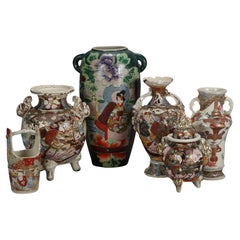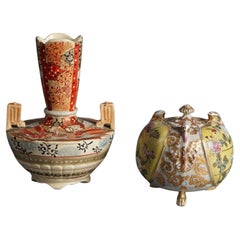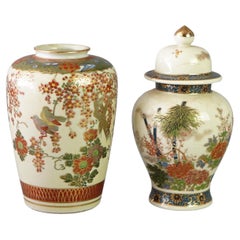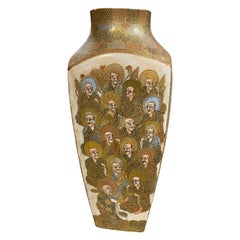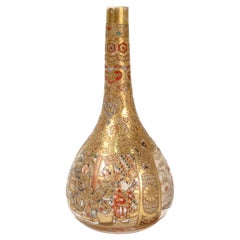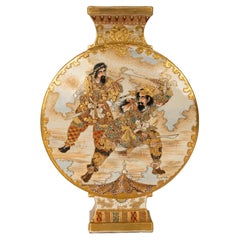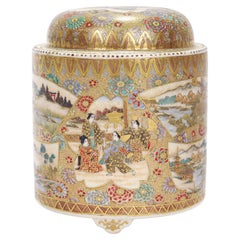Satsuma Pottery
Early 20th Century Pottery
Pottery
Early 20th Century Asian Pottery
Pottery
Early 20th Century Asian Ceramics
Pottery
Early 20th Century Japanese Meiji Ceramics
Earthenware, Pottery
Early 20th Century Asian Ceramics
Ceramic
Early 20th Century Japanese Meiji Ceramics
Pottery
Antique 1880s Japanese Meiji Ceramics
Pottery
Early 20th Century Meiji Ceramics
Pottery
Antique 1890s Japanese Meiji Ceramics
Pottery
Early 20th Century Asian Ceramics
Porcelain
Antique Early 1900s Japanese Meiji Ceramics
Pottery
Antique Early 1900s Japanese Meiji Pottery
Pottery
20th Century Japanese Ceramics
Pottery
20th Century Japanese Vases
Porcelain
20th Century Pottery
Pottery
Antique Late 19th Century Japanese Meiji Table Lamps
Porcelain
Early 20th Century Pottery
Pottery
Early 20th Century Japanese Meiji Vases
Hardwood, Pottery
Antique 19th Century Japanese Meiji Ceramics
Pottery
20th Century Japanese Meiji Vases
Ceramic
Antique Late 19th Century Japanese Pottery
Gold Leaf
Early 20th Century Asian Vases
Pottery
Early 20th Century Japanese Meiji Pottery
Enamel
Antique 1890s Japanese Meiji Ceramics
Porcelain
Antique 1890s Japanese Japonisme Planters, Cachepots and Jardinières
Bronze
Antique Mid-19th Century Japanese Pottery
Porcelain
Early 20th Century Japanese Anglo-Japanese Pottery
Earthenware
Antique Late 19th Century Japanese Meiji Ceramics
Ceramic, Pottery
Antique 19th Century Japanese Meiji Ceramics
Pottery
Antique Late 19th Century Japanese Meiji Ceramics
Pottery
Antique Early 1900s Japanese Meiji Ceramics
Ceramic, Porcelain, Pottery, Stoneware, Hardwood
Antique Late 19th Century Japanese Meiji Ceramics
Pottery
Antique 19th Century Japanese Meiji Ceramics
Earthenware, Pottery
Antique Late 19th Century Japanese Meiji Ceramics
Ceramic
Antique 1890s Japanese Meiji Ceramics
Gold
Antique Late 19th Century Asian Meiji Ceramics
Pottery
Early 20th Century Porcelain
Pottery
Early 20th Century Ceramics
Pottery
Early 20th Century Asian Porcelain
Pottery
Early 20th Century Vases
Pottery
Early 20th Century Asian Ceramics
Pottery
Antique Early 19th Century Asian Ceramics
Porcelain
Antique Early 1900s Japanese Serving Pieces
Pottery
Antique Early 1900s Japanese Meiji Ceramics
Ceramic, Earthenware, Pottery
Vintage 1930s Japanese Ceramics
Ceramic, Earthenware, Pottery
Antique Early 1900s Japanese Meiji Ceramics
Ceramic, Earthenware, Pottery, Faux Leather
Antique Early 1900s Japanese Meiji Ceramics
Ceramic, Earthenware, Pottery
Antique 19th Century Japanese Vases
Porcelain
Antique Late 19th Century Japanese Meiji Ceramics
Ceramic, Earthenware, Pottery
Antique Late 19th Century Japanese Meiji Vases
Ceramic, Earthenware, Pottery
Antique Late 19th Century Japanese Meiji Ceramics
Ceramic, Earthenware, Pottery
Antique Late 19th Century Japanese Meiji Ceramics
Pottery
Early 20th Century Japanese Meiji Vases
Ceramic, Earthenware, Pottery
Early 20th Century Asian Ceramics
Pottery
Early 20th Century Japanese Meiji Ceramics
Pottery
Antique Early 1900s Japanese Meiji Ceramics
Earthenware, Pottery
Antique 18th Century Japanese Edo Vases
Pottery
Antique Early 1900s Japanese Meiji Ceramics
Ceramic, Earthenware, Pottery
Antique Early 1900s Japanese Meiji Ceramics
Ceramic, Earthenware, Pottery
Antique Late 19th Century Japanese Meiji Vases
Ceramic, Earthenware, Pottery
- 1
Satsuma Pottery For Sale on 1stDibs
How Much is a Satsuma Pottery?
- 1stDibs ExpertOctober 7, 2024The difference between Satsuma and moriage is that the former is a type of pottery, and the latter is a technique for decorating pottery. Satsuma pottery is the term for earthenware pottery from Japan's Satsuma region. Although there are different styles, the most common element of Satsuma pottery is a heavy, dark glaze. Moriage is the term for when potters add raised slip decorations to pottery, creating a three-dimensional effect. Some Satsuma pieces show off moriage details, while others do not. Shop a range of Satsuma pottery on 1stDibs.
- Is Satsuma pottery valuable?1 Answer1stDibs ExpertApril 26, 2024Yes, some Satsuma pottery is valuable. The age, type, style and condition will determine how much a particular piece is worth. In addition, the history of ownership may also make a piece more valuable. For example, if a piece was previously in the collection of a notable person, such as a member of the Japanese Imperial Family, it may be worth more. To get an estimated value for a particular piece, consult a certified appraiser or knowledgeable antiques dealer. Find a range of Satsuma pottery on 1stDibs.
- 1stDibs ExpertNovember 4, 2024To identify Satsuma pottery marks, you'll typically need to perform research using trusted online resources. Satsuma is a region in Japan known for its pottery, and many factories and artisans have operated there, including Kinkozan, Taizan, Yasuda, Choshuzan, Fuzan, Gyozan, Koshida and Maruni Kobe. Each maker has its own marks associated with it, and these typically are in Japanese kanji characters. You can compare the characters on your piece to pictures shared online to find a match. Alternatively, a certified appraiser or experienced antique dealer can help you identify your pottery markings. On 1stDibs, shop a selection of Satsuma pottery.
- 1stDibs ExpertSeptember 9, 2024Yes, some Satsuma pottery is worth something. Depending on their age, maker, type, style, condition and other factors, pieces may sell for a few hundred to several thousand dollars. Looking at sales and auction histories can give you a rough idea of the value of a piece. For a more definitive valuation, use the services of a certified appraiser or knowledgeable antique dealer. On 1stDibs, explore a collection of Satsuma pottery.
